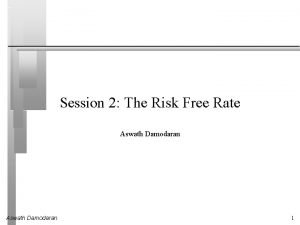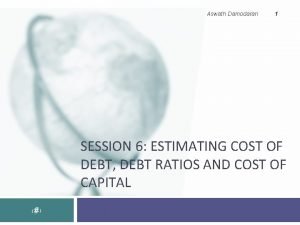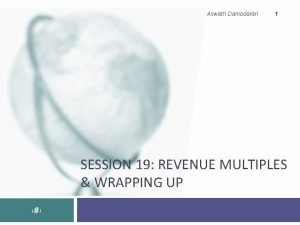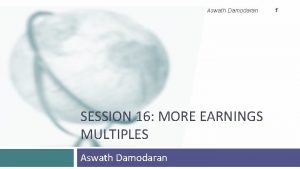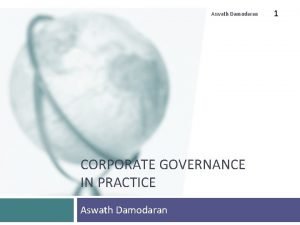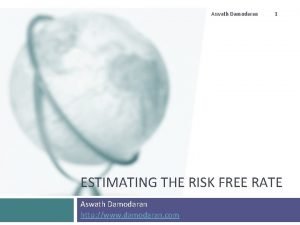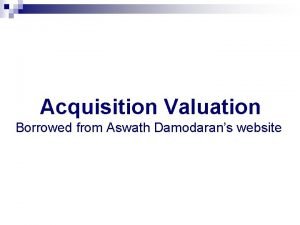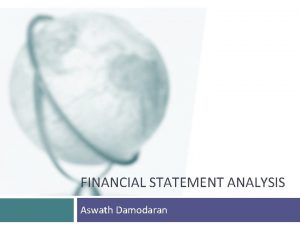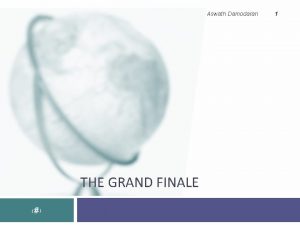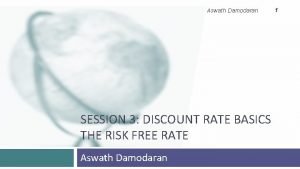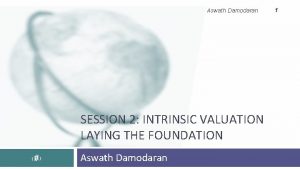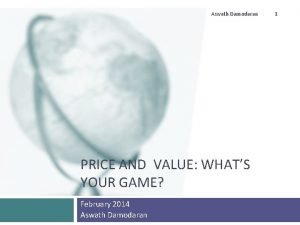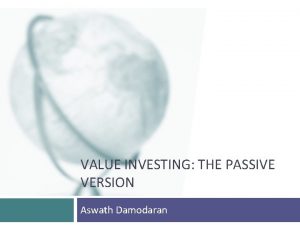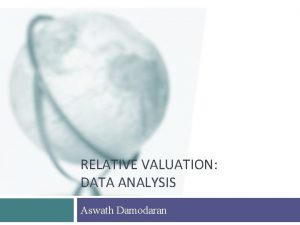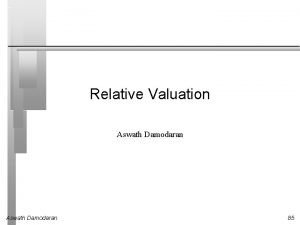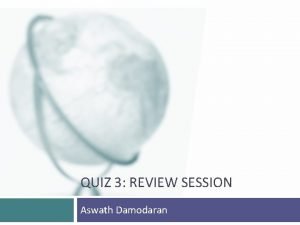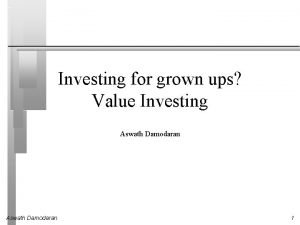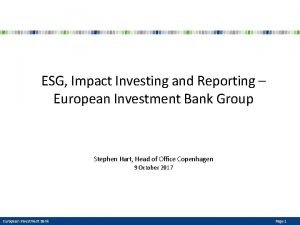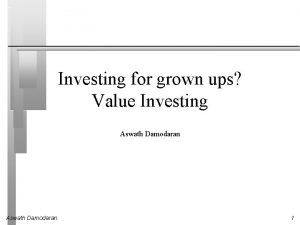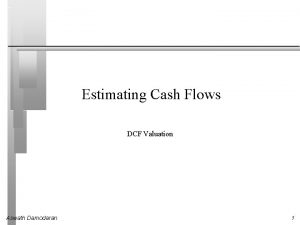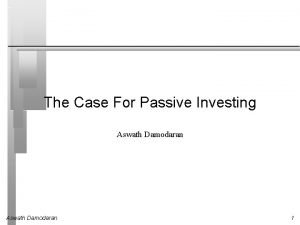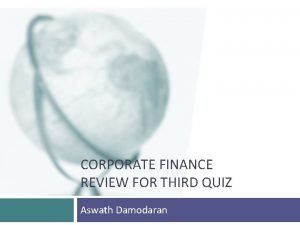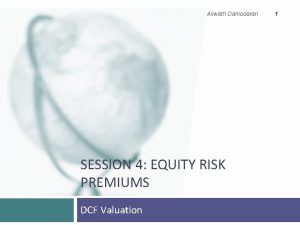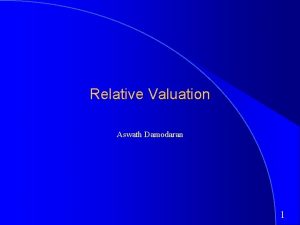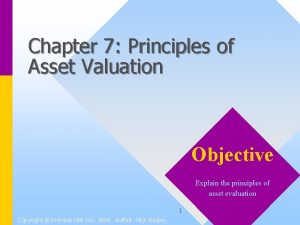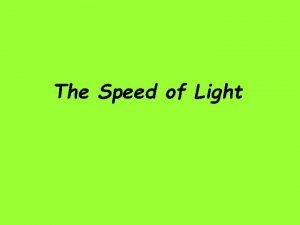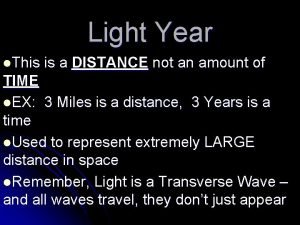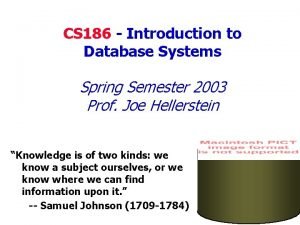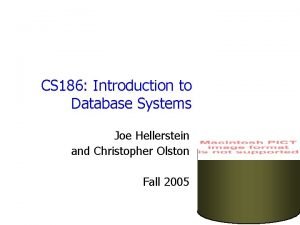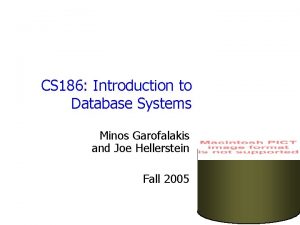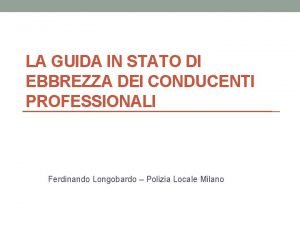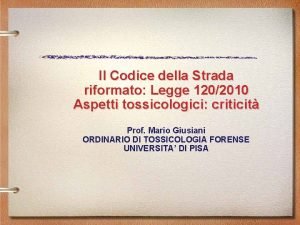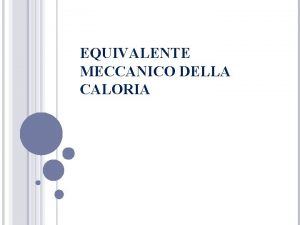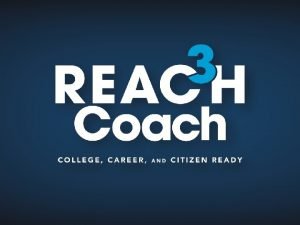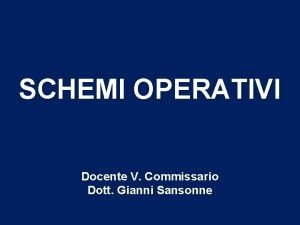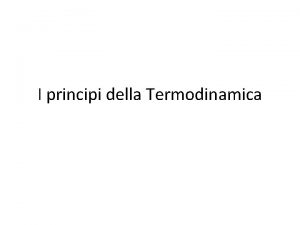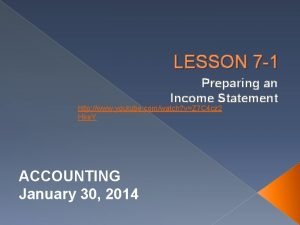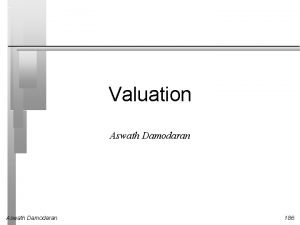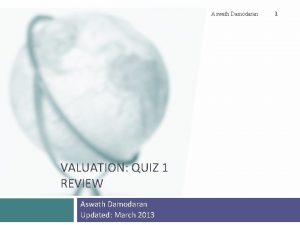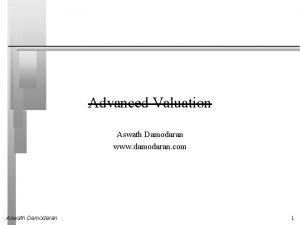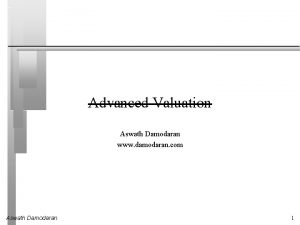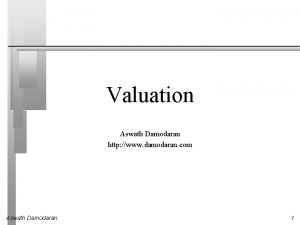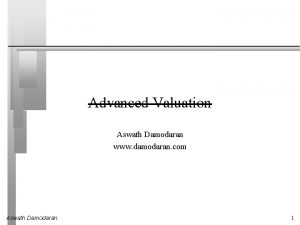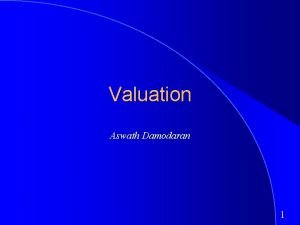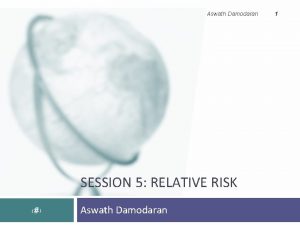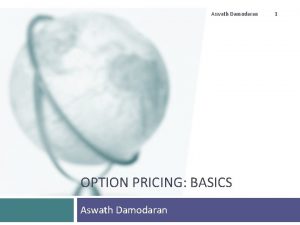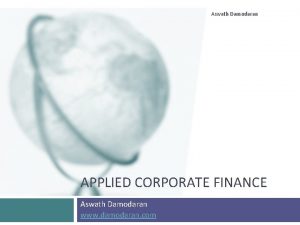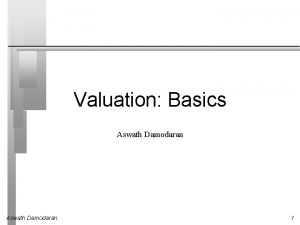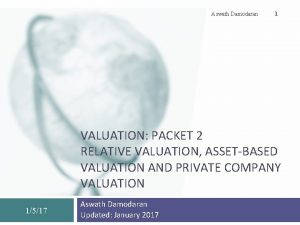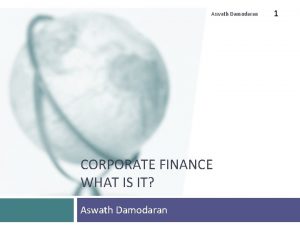Valuation Aswath Damodaran 186 First Principles Invest in






















































- Slides: 54

Valuation Aswath Damodaran 186

First Principles Invest in projects that yield a return greater than the minimum acceptable hurdle rate. • The hurdle rate should be higher for riskier projects and reflect the financing mix used - owners’ funds (equity) or borrowed money (debt) • Returns on projects should be measured based on cash flows generated and the timing of these cash flows; they should also consider both positive and negative side effects of these projects. Choose a financing mix that minimizes the hurdle rate and matches the assets being financed. If there are not enough investments that earn the hurdle rate, return the cash to stockholders. • The form of returns - dividends and stock buybacks - will depend upon the stockholders’ characteristics. Objective: Maximize the Value of the Firm Aswath Damodaran 187

Discounted Cashflow Valuation: Basis for Approach • where, • n = Life of the asset • CFt = Cashflow in period t • r = Discount rate reflecting the riskiness of the estimated cashflows Aswath Damodaran 188

Equity Valuation The value of equity is obtained by discounting expected cashflows to equity, i. e. , the residual cashflows after meeting all expenses, tax obligations and interest and principal payments, at the cost of equity, i. e. , the rate of return required by equity investors in the firm. where, CF to Equityt = Expected Cashflow to Equity in period t ke = Cost of Equity The dividend discount model is a specialized case of equity valuation, and the value of a stock is the present value of expected future dividends. Aswath Damodaran 189

Firm Valuation The value of the firm is obtained by discounting expected cashflows to the firm, i. e. , the residual cashflows after meeting all operating expenses and taxes, but prior to debt payments, at the weighted average cost of capital, which is the cost of the different components of financing used by the firm, weighted by their market value proportions. where, CF to Firmt = Expected Cashflow to Firm in period t WACC = Weighted Average Cost of Capital Aswath Damodaran 190

Generic DCF Valuation Model Aswath Damodaran 191

Estimating Inputs: I. Discount Rates Critical ingredient in discounted cashflow valuation. Errors in estimating the discount rate or mismatching cashflows and discount rates can lead to serious errors in valuation. At an intutive level, the discount rate used should be consistent with both the riskiness and the type of cashflow being discounted. The cost of equity is the rate at which we discount cash flows to equity (dividends or free cash flows to equity). The cost of capital is the rate at which we discount free cash flows to the firm. Aswath Damodaran 192

Estimating Aracruz’s Cost of Equity Average Unlevered Beta for Paper and Pulp firms is 0. 61 Aracruz has a cash balance which was 20% of the market value in 1997, which is much higher than the typical cash balance at other paper and pulp firms. The beta of cash is zero. Unlevered Beta for Aracruz = (0. 8) ( 0. 61) + 0. 2 (0) = 0. 488 Using Aracruz’s gross debt equity ratio of 66. 67% and a tax rate of 33%: Levered Beta for Aracruz = 0. 49 (1+ (1 -. 33) (. 6667)) = 0. 71 Cost of Equity for Aracruz = Real Riskfree Rate + Beta(Premium) = 5% + 0. 71 (7. 5%) = 10. 33% Real Riskfree Rate = 5% (Long term Growth rate in Brazilian economy) Risk Premium = 7. 5% (U. S. Premium + Brazil Risk (from rating)) Aswath Damodaran 193

Estimating Cost of Equity: Deutsche Bank is in two different segments of business - commercial banking and investment banking. To estimate its commercial banking beta, we will use the average beta of commercial banks in Germany. To estimate the investment banking beta, we will use the average bet of investment banks in the U. S and U. K. Comparable Firms Average Beta Weight Commercial Banks in Germany 0. 90 90% U. K. and U. S. investment banks 1. 30 10% Beta for Deutsche Bank = 0. 9 (. 90) + 0. 1 (1. 30)= 0. 94 Cost of Equity for Deutsche Bank (in DM) = 7. 5% + 0. 94 (5. 5%) = 12. 67% Aswath Damodaran 194

Reviewing Disney’s Costs of Equity & Debt Business Creative Content Retailing Broadcasting Theme Parks Real Estate Disney Unlevered Beta 1. 25 1. 50 0. 90 1. 10 0. 70 1. 09 D/E Ratio Levered Beta 20. 92% 1. 42 20. 92% 1. 70 20. 92% 1. 02 20. 92% 1. 26 59. 27% 0. 92 21. 97% 1. 25 Riskfree Rate 7. 00% Risk Premium 5. 50% Cost of Equity 14. 80% 16. 35% 12. 61% 13. 91% 12. 31% 13. 85% Disney’s Cost of Debt (based upon rating) = 7. 50% Aswath Damodaran 195

Estimating Cost of Capital: Disney Equity • Cost of Equity = • Market Value of Equity = • Equity/(Debt+Equity ) = Debt • After-tax Cost of debt = • Market Value of Debt = • Debt/(Debt +Equity) = 13. 85% $50. 88 Billion 82% 7. 50% (1 -. 36) = 4. 80% $ 11. 18 Billion 18% Cost of Capital = 13. 85%(. 82)+4. 80%(. 18) = 12. 22% Aswath Damodaran 196

II. Estimating Cash Flows Aswath Damodaran 197

Estimating FCFE next year: Aracruz All inputs are per share numbers: Earnings BR 0. 222 - (Cap. Ex-Depreciation)*(1 -DR) BR 0. 042 -Chg. Working Capital*(1 -DR) BR 0. 018 Free Cashflow to Equity BR 0. 170 Earnings: Since Aracruz’s 1996 earnings are “abnormally” low, I used the average earnings per share from 1992 to 1996. Capital Expenditures per share next year = 0. 24 BR/share Depreciation per share next year = 0. 18 BR/share Change in Working Capital = 0. 03 BR/share Debt Ratio = 39% Aswath Damodaran 198

Estimating FCFF: Disney EBIT = $5, 559 Million Capital spending = $ 1, 746 Million Depreciation = $ 1, 134 Million Increase in Non-cash Working capital = $ 617 Million Estimating FCFF EBIT (1 -t) $ + Depreciation $ - Capital Expenditures $ - Change in WC $ = FCFF $ Aswath Damodaran 3, 558 1, 134 1, 746 617 2, 329 Million 199

6 Application Test: Estimating your firm’s FCFF Estimate the FCFF for your firm in its most recent financial year: In general, If using statement of cash flows EBIT (1 -t) + Depreciation - Capital Expenditures + Capital Expenditures - Change in Non-cash WC + Change in Non-cash WC = FCFF Estimate the dollar reinvestment at your firm: Reinvestment = EBIT (1 -t) - FCFF Aswath Damodaran 200

Choosing a Cash Flow to Discount When you cannot estimate the free cash fllows to equity or the firm, the only cash flow that you can discount is dividends. For financial service firms, it is difficult to estimate free cash flows. For Deutsche Bank, we will be discounting dividends. If a firm’s debt ratio is not expected to change over time, the free cash flows to equity can be discounted to yield the value of equity. For Aracruz, we will discount free cash flows to equity. If a firm’s debt ratio might change over time, free cash flows to equity become cumbersome to estimate. Here, we would discount free cash flows to the firm. For Disney, we will discount the free cash flow to the firm. Aswath Damodaran 201

III. Expected Growth Aswath Damodaran 202

Expected Growth in EPS g. EPS = Retained Earningst-1/ NIt-1 * ROE = Retention Ratio * ROE = b * ROE • Proposition 1: The expected growth rate in earnings for a company cannot exceed its return on equity in the long term. Aswath Damodaran 203

Estimating Expected Growth in EPS: Disney, Aracruz and Deutsche Bank Company Exp ROE Retention Exp. Forecast. Retention Ratio Growth ROE Ratio Growth Disney 24. 95% 77. 68% 19. 38% 25% 77. 68% 19. 42% Aracruz 2. 22% 65. 00% 1. 44% 13. 91% 65. 00% 9. 04% Deutsche Bank 7. 25% 39. 81% 2. 89% 14. 00% 45. 00% 6. 30% ROE: Return on Equity for most recent year Forecasted ROE = Expected ROE for the next 5 years • For Disney, forecasted ROE is expected to be close to current ROE • For Aracruz, the average ROE between 1994 and 1996 is used, since 1996 was a abnormally bad year • For Deutsche Bank, the forecast ROE is set equal to the average ROE for German banks Aswath Damodaran 204

ROE and Leverage ROE = ROC + D/E (ROC - i (1 -t)) where, ROC = (EBIT (1 - tax rate)) / Book Value of Capital = EBIT (1 - t) / Book Value of Capital D/E = BV of Debt/ BV of Equity i = Interest Expense on Debt / Book Value of Debt t = Tax rate on ordinary income Note that BV of Capital = BV of Debt + BV of Equity. Aswath Damodaran 205

Decomposing ROE: Disney in 1996 Return on Capital = (EBIT(1 -tax rate) / (BV: Debt + BV: Equity) = 5559 (1 -. 36)/ (7663+11668) = 18. 69% Debt Equity Ratio = Book Value of Debt/ Book Value of Equity= 45% Interest Rate on Debt = 7. 50% Expected Return on Equity = ROC + D/E (ROC - i(1 -t)) = 18. 69 % +. 45 (18. 69% - 7. 50(1 -. 36)) = 24. 95% Aswath Damodaran 206

Expected Growth in EBIT And Fundamentals Reinvestment Rate and Return on Capital g. EBIT = (Net Capital Expenditures + Change in WC)/EBIT(1 -t) * ROC = Reinvestment Rate * ROC Proposition 2: No firm can expect its operating income to grow over time without reinvesting some of the operating income in net capital expenditures and/or working capital. Proposition 3: The net capital expenditure needs of a firm, for a given growth rate, should be inversely proportional to the quality of its investments. Aswath Damodaran 207

Estimating Growth in EBIT: Disney Actual reinvestment rate in 1996 = (Net Cap Ex+ Chg in WC)/ EBIT (1 -t) • • Net Cap Ex in 1996 = (1745 -1134) Change in Working Capital = 617 EBIT (1 - tax rate) = 5559(1 -. 36) Reinvestment Rate = (1745 -1134+617)/(5559*. 64)= 34. 5% Forecasted Reinvestment Rate = 50% Return on Capital =20% (Higher than this year’s 18. 69%) Expected Growth in EBIT =. 5(20%) = 10% The forecasted reinvestment rate is much higher than the actual reinvestment rate in 1996, because it includes projected acquisition. Between 1992 and 1996, adding in the Capital Cities acquisition to all capital expenditures would have yielded a reinvestment rate of roughly 50%. Aswath Damodaran 208

6 Application Test: Estimating Expected Growth Estimate the following: • The reinvestment rate for your firm • The after-tax return on capital • The expected growth in operating income, based upon these inputs Aswath Damodaran 209

IV. Getting Closure in Valuation A publicly traded firm potentially has an infinite life. The value is therefore the present value of cash flows forever. Since we cannot estimate cash flows forever, we estimate cash flows for a “growth period” and then estimate a terminal value, to capture the value at the end of the period: Aswath Damodaran 210

Stable Growth and Terminal Value When a firm’s cash flows grow at a “constant” rate forever, the present value of those cash flows can be written as: Value = Expected Cash Flow Next Period / (r - g) where, r = Discount rate (Cost of Equity or Cost of Capital) g = Expected growth rate This “constant” growth rate is called a stable growth rate and cannot be higher than the growth rate of the economy in which the firm operates. While companies can maintain high growth rates for extended periods, they will approach “stable growth” at some point in time. When they do approach stable growth, the valuation formula above can be used to estimate the “terminal value” of all cash flows beyond. Aswath Damodaran 211

Growth Patterns A key assumption in all discounted cash flow models is the period of high growth, and the pattern of growth during that period. In general, we can make one of three assumptions: • there is no high growth, in which case the firm is already in stable growth • there will be high growth for a period, at the end of which the growth rate will drop to the stable growth rate (2 -stage) • there will be high growth for a period, at the end of which the growth rate will decline gradually to a stable growth rate(3 -stage) The assumption of how long high growth will continue will depend upon several factors including: • the size of the firm (larger firm -> shorter high growth periods) • current growth rate (if high -> longer high growth period) • barriers to entry and differential advantages (if high -> longer growth period) Aswath Damodaran 212

Length of High Growth Period Assume that you are analyzing two firms, both of which are enjoying high growth. The first firm is Earthlink Network, an internet service provider, which operates in an environment with few barriers to entry and extraordinary competition. The second firm is Biogen, a biotechnology firm which is enjoying growth from two drugs to which it owns patents for the next decade. Assuming that both firms are well managed, which of the two firms would you expect to have a longer high growth period? Earthlink Network Biogen Both are well managed and should have the same high growth period Aswath Damodaran 213

Choosing a Growth Pattern: Examples Company Valuation in Growth Period Stable Growth Disney Nominal U. S. $ 10 years 5%(long term Firm (3 -stage) nominal growth rate in the U. S. economy Aracruz Real BR 5 years 5%: based upon Equity: FCFE (2 -stage) expected long term real growth rate for Brazilian economy Deutsche Bank Nominal DM 0 years 5%: set equal to Equity: Dividends nominal growth rate in the world economy Aswath Damodaran 214

Firm Characteristics as Growth Changes Variable High Growth Firms tend to Stable Growth Firms tend to Risk be above-average risk be average risk Dividend Payout pay little or no dividends pay high dividends Net Cap Ex have high net cap ex have low net cap ex Return on Capital earn high ROC (excess return) earn ROC closer to WACC Leverage have little or no debt higher leverage Aswath Damodaran 215

Estimating Stable Growth Inputs Start with the fundamentals: • Profitability measures such as return on equity and capital, in stable growth, can be estimated by looking at – industry averages for these measure, in which case we assume that this firm in stable growth will look like the average firm in the industry – cost of equity and capital, in which case we assume that the firm will stop earning excess returns on its projects as a result of competition. • Leverage is a tougher call. While industry averages can be used here as well, it depends upon how entrenched current management is and whether they are stubborn about their policy on leverage (If they are, use current leverage; if they are not; use industry averages) Use the relationship between growth and fundamentals to estimate payout and net capital expenditures. Aswath Damodaran 216

Estimating Stable Period Net Cap Ex g. EBIT = (Net Capital Expenditures + Change in WC)/EBIT(1 -t) * ROC = Reinvestment Rate * ROC Moving terms around, Reinvestment Rate = g. EBIT / Return on Capital For instance, assume that Disney in stable growth will grow 5% and that its return on capital in stable growth will be 16%. The reinvestment rate will then be: Reinvestment Rate for Disney in Stable Growth = 5/16 = 31. 25% In other words, • the net capital expenditures and working capital investment each year during the stable growth period will be 31. 25% of after-tax operating income. Aswath Damodaran 217

Valuation: Deutsche Bank Sustainable growth at Deutsche Bank = ROE * Retention Ratio = 14% (. 45) = 6. 30% { I used the normalized numbers for this] Cost of equity = 7. 5% + 0. 94 (5. 5%) = 12. 67%. Current Dividends per share = 2. 61 DM Model Used: • Stable Growth (Large firm; Growth is close to stable growth already) • Dividend Discount Model (FCFE is tough to estimate) Valuation • Expected Dividends per Share next year = 2. 61 DM (1. 063) = 2. 73 DM • Value per Share = 2. 73 DM / (. 1267 -. 063) = 42. 89 DM Deutsche Bank was trading for 119 DM on the day of this analysis. Aswath Damodaran 218

What does the valuation tell us? Stock is tremendously overvalued: This valuation would suggest that Deutsche Bank is significantly overvalued, given our estimates of expected growth and risk. Dividends may not reflect the cash flows generated by Deutsche Bank. The. FCFE could have been significantly higher than the dividends paid. Estimates of growth and risk are wrong: It is also possible that we have underestimated growth or overestimated risk in the model, thus reducing our estimate of value. Aswath Damodaran 219

Valuation: Aracruz Cellulose The current earnings per share for Aracruz Cellulose is 0. 044 BR. These earnings are abnormally low. To normalize earnings, we use the average earnings per share between 1994 and 1996 of 0. 204 BR per share as a measure of the normalized earnings per share. Model Used: • Real valuation (since inflation is still in double digits) • 2 -Stage Growth (Firm is still growing in a high growth economy) • FCFE Discount Model (Dividends are lower than FCFE: See Dividend section) Aswath Damodaran 220

Aracruz Cellulose: Inputs for Valuation High Growth Phase Stable Growth Phase Length 5 years Forever, after year 5 Expected Growth Retention Ratio * ROE 5% (Real Growth Rate in Brazil) = 0. 65 * 13. 91%= 8. 18% Cost of Equity 5% + 0. 71 (7. 5%) = 10. 33% 5% + 1(7. 5%) = 12. 5% (Beta =0. 71; Rf=5%) (Assumes beta moves to 1) Net Capital Expenditures Net capital ex grows at same Capital expenditures are assumed rate as earnings. Next year, to be 120% of depreciation capital ex will be 0. 24 BR and deprec’n will be 0. 18 BR. Working Capital 32. 15% of Revenues; Revenues grow at same rate as earnings in both periods. Debt Ratio 39. 01% of net capital ex and working capital investments come from debt. Aswath Damodaran 221

Aracruz: Estimating FCFE for next 5 years 1 2 0. 222 BR 0. 243 BR 0. 264 - (Cap. Ex-Depreciation)*(1 -DR) 0. 052 -Chg. Working Capital*(1 -DR) 0. 008 Free Cashflow to Equity BR 0. 170 Present Value BR 0. 154 3 4 5 Terminal Earnings BR 0. 288 BR 0. 314 BR 0. 330 BR 0. 042 BR 0. 046 BR 0. 050 BR 0. 055 BR 0. 060 BR BR 0. 010 BR 0. 011 BR 0. 012 BR 0. 013 BR 0. 014 BR BR 0. 186 BR 0. 152 BR 0. 202 BR 0. 150 BR 0. 221 BR 0. 241 BR 0. 269 BR 0. 147 BR The present value is computed by discounting the FCFE at the current cost of equity of 10. 33%. Aswath Damodaran 222

Aracruz: Estimating Terminal Price and Value per share The terminal value at the end of year 5 is estimated using the FCFE in the terminal year. • The FCFE in year 6 reflects the drop in net capital expenditures after year 5. • Terminal Value = 0. 269/(. 125 -. 05) = 3. 59 BR • Value per Share = 0. 154 + 0. 152 + 0. 150 + 0. 149 + 0. 147 + 3. 59/1. 10335 = 2. 94 BR The stock was trading at 2. 40 BR in September 1997. The value per share is based upon normalized earnings. To the extent that it will take some time to get t normal earnings, discount this value per share back to the present at the cost of equity of 10. 33%. Aswath Damodaran 223

Disney Valuation Model Used: • Cash Flow: FCFF (since I think leverage will change over time) • Growth Pattern: 3 -stage Model (even though growth in operating income is only 10%, there are substantial barriers to entry) Aswath Damodaran 224

Disney: Inputs to Valuation Aswath Damodaran 225

Disney: FCFF Estimates Aswath Damodaran 226

Disney: Costs of Capital Aswath Damodaran 227

Disney: Terminal Value The terminal value at the end of year 10 is estimated based upon the free cash flows to the firm in year 11 and the cost of capital in year 11. FCFF 11 = EBIT (1 -t) - EBIT (1 -t) Reinvestment Rate = $ 13, 539 (1. 05) (1 -. 36) - $ 13, 539 (1. 05) (1 -. 36) (. 3125) = $ 6, 255 million Note that the reinvestment rate is estimated from the cost of capital of 16% and the expected growth rate of 5%. Cost of Capital in terminal year = 10. 19% Terminal Value = $ 6, 255/(. 1019 -. 05) = $ 120, 521 million Aswath Damodaran 228

Disney: Present Value Aswath Damodaran 229

Present Value Check The FCFF and costs of capital are provided for all 10 years. Confirm the present value of the FCFF in year 7. Aswath Damodaran 230

Disney: Value Per Share Value of the Firm = $ 57, 817 million + Value of Cash = $ 0 (almost no non-operating cash - Value of Debt = $ 11, 180 million = Value of Equity = $ 46, 637 million / Number of Shares 675. 13 Value Per Share = $ 69. 08 Aswath Damodaran 231

Aswath Damodaran 232

Aswath Damodaran 233

Relative Valuation In relative valuation, the value of an asset is derived from the pricing of 'comparable' assets, standardized using a common variable such as earnings, cashflows, book value or revenues. Examples include - • Price/Earnings (P/E) ratios – and variants (EBIT multiples, EBITDA multiples, Cash Flow multiples) • Price/Book (P/BV) ratios – and variants (Tobin's Q) • Price/Sales ratios Aswath Damodaran 234

MULTIPLES AND DCF VALUATION Gordon Growth Model: Dividing both sides by the earnings, Dividing both sides by the book value of equity, If the return on equity is written in terms of the retention ratio and the expected growth rate Dividing by the Sales per share, Aswath Damodaran 235

Disney: Relative Valuation Company PE Expected Growth King World Productions 10. 4 Aztar 11. 9 12. 00% 0. 99 Viacom 12. 1 18. 00% 0. 67 All American Communications 15. 8 GC Companies 20. 2 15. 00% Circus Enterprises 20. 8 Polygram NV ADR 22. 6 13. 00% Regal Cinemas 25. 8 23. 00% Walt Disney 27. 9 18. 00% AMC Entertainment 29. 5 20. 00% Premier Parks 32. 9 28. 00% Family Golf Centers 33. 1 36. 00% CINAR Films 48. 4 25. 00% Average 22. 19 18. 56% 1. 20 Aswath Damodaran PEG 7. 00% 20. 00% 1. 35 17. 00% 1. 74 1. 12 1. 55 1. 48 1. 18 0. 92 1. 94 1. 49 0. 79 1. 22 236

Is Disney fairly valued? Based upon the PE ratio, is Disney under, over or correctly valued? Under Valued Over Valued Correctly Valued Based upon the PEG ratio, is Disney under valued? Under Valued Over Valued Correctly Valued Will this valuation give you a higher or lower valuation than the discounted CF valutaion? Higher Lower Aswath Damodaran 237

Relative Valuation Assumptions Assume that you are reading an equity research report where a buy recommendation for a company is being based upon the fact that its PE ratio is lower than the average for the industry. Implicitly, what is the underlying assumption or assumptions being made by this analyst? The sector itself is, on average, fairly priced The earnings of the firms in the group are being measured consistently The firms in the group are all of equivalent risk The firms in the group are all at the same stage in the growth cycle The firms in the group are of equivalent risk and have similar cash flow patterns All of the above Aswath Damodaran 238

First Principles Invest in projects that yield a return greater than the minimum acceptable hurdle rate. • The hurdle rate should be higher for riskier projects and reflect the financing mix used - owners’ funds (equity) or borrowed money (debt) • Returns on projects should be measured based on cash flows generated and the timing of these cash flows; they should also consider both positive and negative side effects of these projects. Choose a financing mix that minimizes the hurdle rate and matches the assets being financed. If there are not enough investments that earn the hurdle rate, return the cash to stockholders. • The form of returns - dividends and stock buybacks - will depend upon the stockholders’ characteristics. Objective: Maximize the Value of the Firm Aswath Damodaran 239
 Aswath damodaran startup valuation
Aswath damodaran startup valuation Default spread damodaran
Default spread damodaran Types of investment philosophies
Types of investment philosophies Http://www.damodaran.com
Http://www.damodaran.com Value investing damodaran
Value investing damodaran Aswath damodaran statistics
Aswath damodaran statistics Ratings interest coverage ratios and default spread 2021
Ratings interest coverage ratios and default spread 2021 Damodaran multiple
Damodaran multiple Aswath damodaran net worth
Aswath damodaran net worth Damodaran discount rate
Damodaran discount rate Damodaran ebitda multiples
Damodaran ebitda multiples Aswath damodaran age
Aswath damodaran age Default spread damodaran
Default spread damodaran Aswath damodaran website
Aswath damodaran website Contrarian value investing
Contrarian value investing Aswath damodaran accounting
Aswath damodaran accounting Aswath damodaran
Aswath damodaran Damodaran discount rates
Damodaran discount rates Aswath damodaran intrinsic value
Aswath damodaran intrinsic value Aswath damodaran intrinsic value
Aswath damodaran intrinsic value Aswath damodaran value investing
Aswath damodaran value investing Aswath damodaran formação
Aswath damodaran formação Aswath damodaran data
Aswath damodaran data Damodaran relative valuation
Damodaran relative valuation Damodaran on valuation review
Damodaran on valuation review Damodaran
Damodaran Damodaran discount rate
Damodaran discount rate Aswath damodaran esg
Aswath damodaran esg Damodaran value investing
Damodaran value investing Damodaran dcf
Damodaran dcf Aswath damodaran
Aswath damodaran Quiz
Quiz Erp damodaran
Erp damodaran Relative valuation
Relative valuation Damodaran private company valuation
Damodaran private company valuation Fixed income introduction
Fixed income introduction 7 principles of valuation
7 principles of valuation How fast does light travel
How fast does light travel Schema operativo art 186 c.d.s. 2019
Schema operativo art 186 c.d.s. 2019 186 000 miles/sec in mph
186 000 miles/sec in mph Cs 186
Cs 186 Joe hellerstein’s berkeley cs 186
Joe hellerstein’s berkeley cs 186 Joe hellerstein’s berkeley cs 186
Joe hellerstein’s berkeley cs 186 186pg
186pg Art 186 cds
Art 186 cds Art 186 cds
Art 186 cds Equivalente meccanico del calore
Equivalente meccanico del calore 186 282 miles per second into meters per second
186 282 miles per second into meters per second 186
186 Gianni sansonne
Gianni sansonne Tungsten-186
Tungsten-186 Principi termodinamica
Principi termodinamica Round 170 to the nearest hundred
Round 170 to the nearest hundred 7-1 work together p. 186 answers
7-1 work together p. 186 answers Knights of columbus form 186
Knights of columbus form 186

